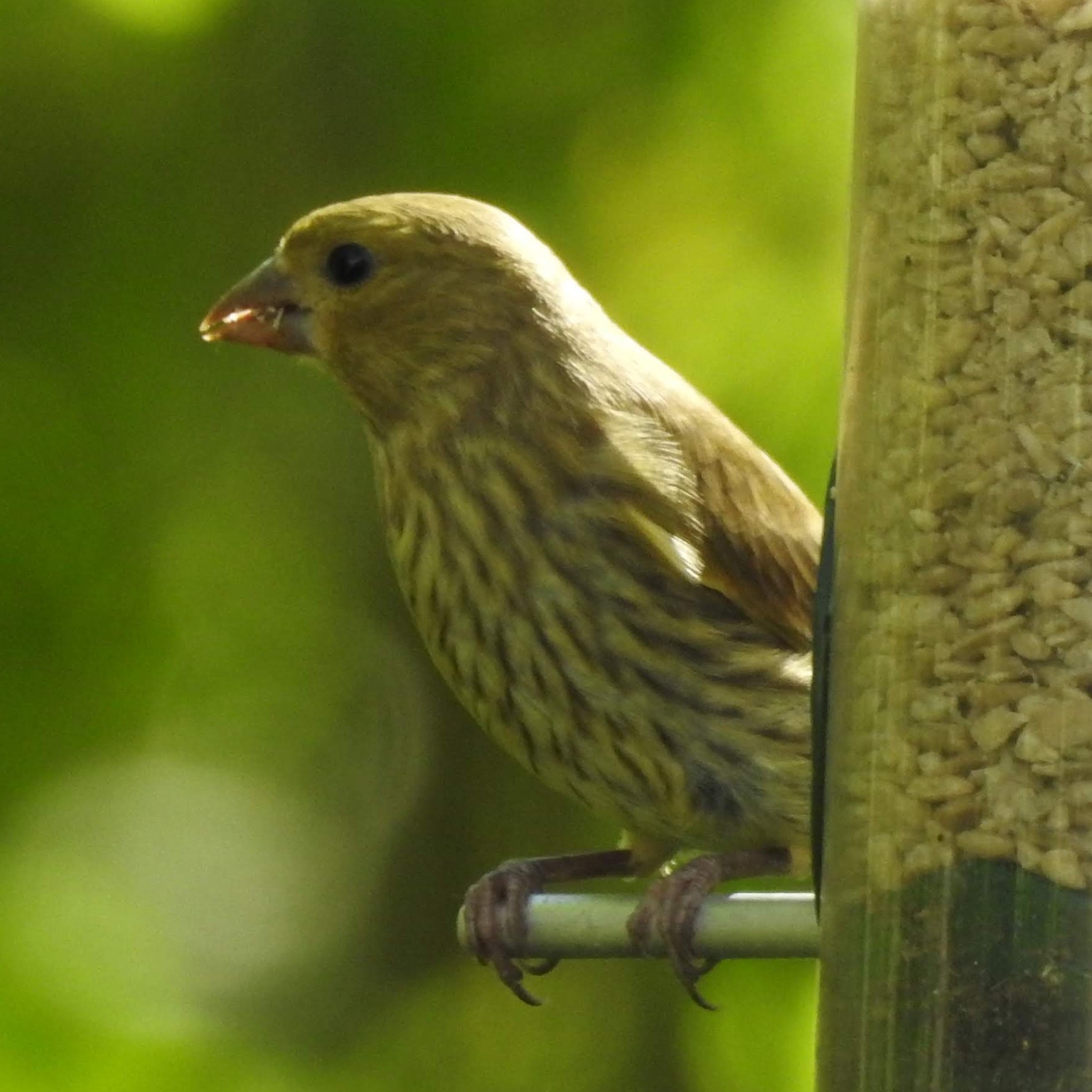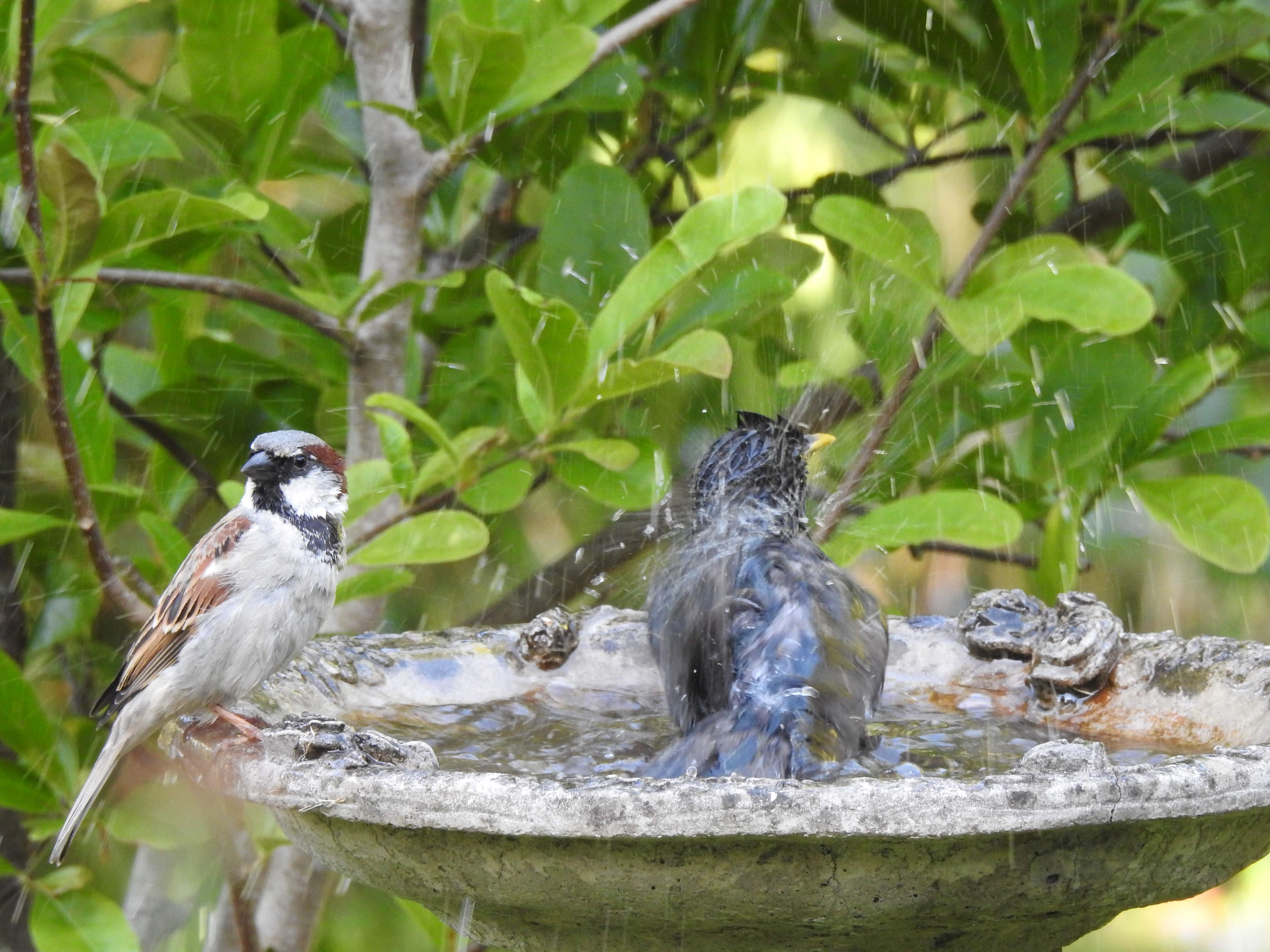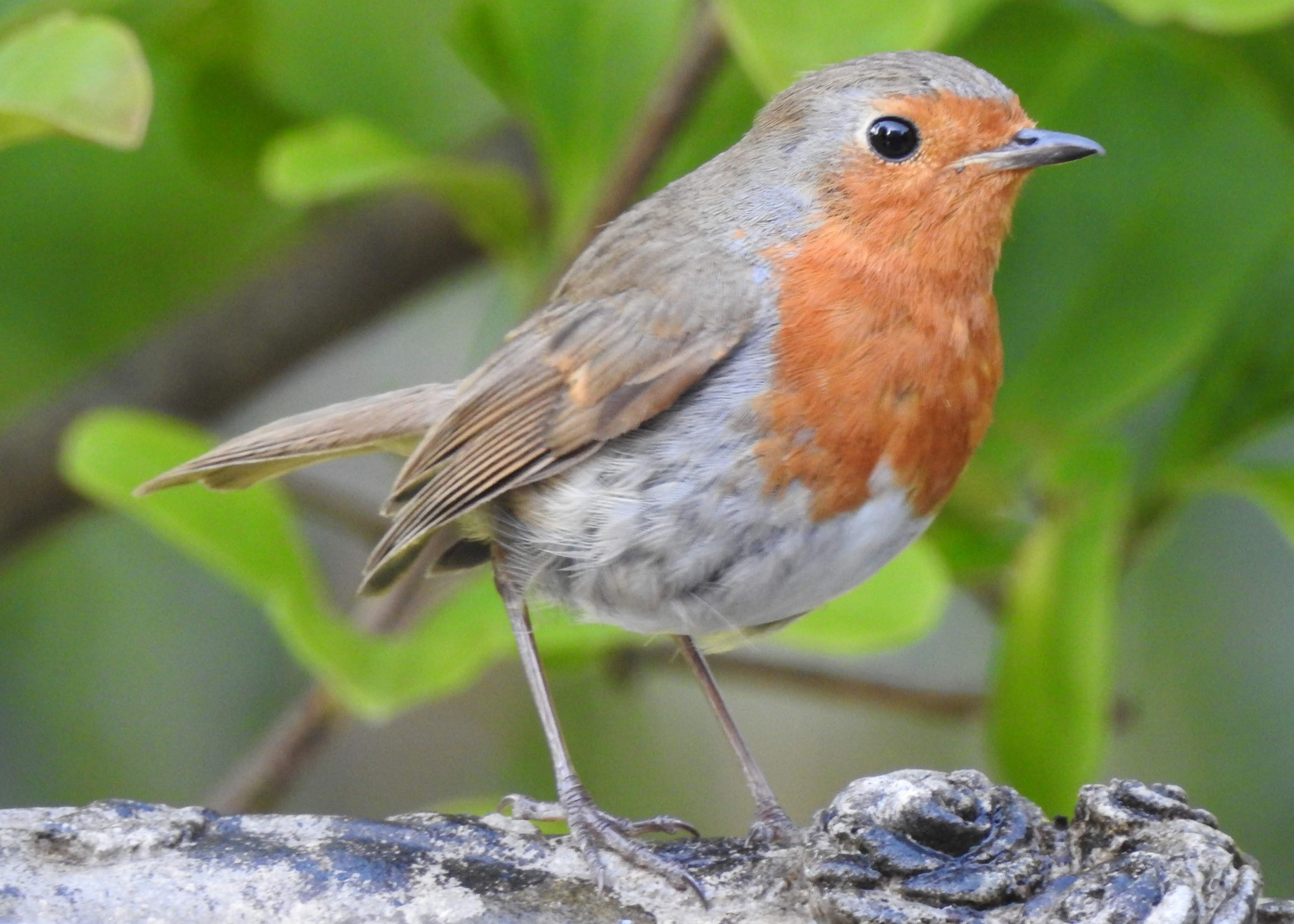If you live in the UK then you may have heard of the annual Great British Birdwatch run by the RSPB. Well there is another, which is even more informative. For quarter of a century the British Trust for Ornithology has been running a year round Garden Birdwatch, and there are now thousands of people contributing their sightings every week. This year, because of Covid-19, they are giving everyone free access to BTO Garden BirdWatch. Not sure how long free access will remain with the lockdown easing (bonkers decision) commencing, but if you have sight of a garden and can identify most common British garden birds by sight why not join in for as long as you can.

I have been contributing for the past seven weeks. Sometimes just sitting observing and other times darting to the window when I spot something on one of the feeders or the bird bath. It has been such a lovely way to while away time. It has also, as you can see from this post, encouraged me to get the camera out in the garden.



I have been struck by both the variety of species and how it varies from week to week. On average we see 15 different species in our garden each week, with some birds only appearing occasionally and others multiple times throughout the week.





I now have a notebook where I write down a list of what I have seen to date, and then as and when I spot them in the garden I note down how many there are at any one point. To date the most I have seen of anyone species is 8, when the starlings fledged.




There are clear instructions how to count and record, which is why even though I know we have robins nesting nearby I rarely record two since it has been rare for me to see more than one at any one time, likewise the blue tits. And even though I have seen a kite and swifts overhead I cannot include them as they were not using the resources in our garden.

Thanks to 25years of reported sightings the BTO now has a wealth of information on how the populations of garden birds are changing. For example Goldfinches are now in the top ten of birds commonly seen in British gardens; 25 years ago they were only just in the top 20. The saddest change for our gardens is that Song Thrushes have dropped right down, although their numbers in the wider countryside remain stable.
There are now over 56,000 gardens registered. Some 250 gardens which were reporting in 1995 are still reporting today, and one person has submitted over 1,300 weekly reports. That’s almost a weekly report every week for 25 years!
You can also record sightings of butterflies, dragonflies, mammals and other insects. I’ve not been so great on the other sightings mainly because I am hopeless at identification, however I am getting better. Even Septimus gets counted under mammals.






















I need to get back into iNatural, which is one of America’s versions of the same thing. There is also a group run by Cornell University to which I belong. Right now, the squirrels are getting very possessive of the feeders and if they don’t let go, I’ll have to take down the feeder for a few weeks until everyone discovers that there really IS food out in the now leafy woodlands surrounding us. Lots of bugs, too. Please, my feathered friends, EAT BUGS.
Your pictures are wonderful!! I have been trying to relate our birds to yours. Clearly many are related, even though their colors are not the same. Some ARE the same because they were brought over here from there and vice versa, which isn’t a good thing, but I can’t regret the beautiful mute swans that came from England!
LikeLiked by 1 person
Thank you so much Marilyn, and yes fascinating which birds cross the pond. As you say some naturally and others unfortunately introduced.
LikeLike
PS Do hope you do get back into inatural
LikeLike
Nice set of photos. I think the Garden Birdwatch is such a good idea. It not only produces information, but encourages people to pay more attention to wildlife in gardens and elsewhere.
LikeLiked by 1 person
Thanks Graham.
You are so right about Garden Birdwatch. I’ve always been pretty good at observing our garden visitors but even so it has had such a big impact on us. We’ve really noticed changes and additions since we started. Just brilliant!
LikeLiked by 1 person
Beautiful photos Becky, especially of the robin.
LikeLiked by 1 person
Thank you 🙂 it’s been fun just sitting out there watching
LikeLike
Nice photos of your bird visitors. We have a feeder and small bird bath ust outside our eat-in kitchen. We are always entertained. The squirrels and little chipmunks pick up anything birds drop from the feeder. We also have a humminbird feeder out as they are back now. Your garden looks like a haven for the birds.
LikeLiked by 1 person
The birds seem to think so 🙂
I’m so envious you have hummingbirds visiting. I’d love to live somewhere where hummingbird feeders are an option!
LikeLiked by 1 person
Watching birds is a lovely pastime, and they seem to love us, humans, for creating birdbaths for them. Those are lovely bird photos, Becky. The garden looks very inviting; we were so fortunate to housesit in the UK for many who loved birds and gardening. Though I remember squirrels visiting to eat the bird food and all hell breaking loose when the dog found out 🙂
LikeLiked by 1 person
Thank you so much Suzanne.
Our garden is overgrown but a lovely bit of greenery to sit out in. You wouldn’t know we are in a urban area sometimes!
LikeLike
It’s great when gardens create an oasis no matter how small or big it is. Crazy to think I was looking after an acre of gardens as well as an orchard now we have trees/flowers/herbs in pots which gives us a “garden” 🙂
LikeLike
wow acre is a lot. I’ve lived in places with acres and know it is beyond me!
LikeLike
Lots of trees and shrubs and I eventually had to pull out all the roses as it did become too much work. We sold it 13 years ago.
LikeLike
pots are so much easier aren’t they 🙂 . . although needing lots of water here at the moment!
LikeLike
Not a problem for us at the moment 🙂
LikeLiked by 1 person
Great photos of birds. You must know how to wait patiently and stand still! You have many different species than we do in the Midwestern United States. Cool to see.
LikeLiked by 1 person
Thank you so much. And yes I’m very good at sitting and waiting!!
LikeLike
The birds trust you to let you get that close.
LikeLike
We sit very still, and I have a good zoom!
LikeLiked by 1 person
Hi Becky, this is delightful, and how wonderful to have such fabulous visitors in your garden. Thank goodness Septimus seems completely unfazed by their singing 🙂
LikeLiked by 1 person
Thanks Clare, and yes we’re so thankful he’s not a birder. He does though have three bells on his collar just in case!!
LikeLiked by 1 person
wonderful visitors beautifully captured! thanks for sharing 🙂
LikeLiked by 1 person
Thank you so much for the lovely feedback 🙂
LikeLike
What a fabulous post with such great photos. I just might do this BTO thing, though my identification skills can be a bit mixed.
LikeLiked by 1 person
Go for it Margaret . . don’t worry if you cannot identify everything as long as you can do majority. You don’t even need to count, you can just say you saw a blackbird or robin!
LikeLiked by 1 person
The real candidate is one particular blackbird who sings so loudly, morning, noon and night that we can hear him even through closed windows. He’s wonderful!
LikeLiked by 1 person
Hope you treat him to say thank you for all his singing!
LikeLiked by 1 person
Of course!
LikeLiked by 1 person
Just spotted the BTO produce this helpful guide – https://www.bto.org/sites/default/files/gbw_recording_form_spring.pdf
LikeLike
You have a great variety coming in! A great way to spend the day… my new pastime too! We have sparrows all day along with a few others and a red cardinal visiting occasionally playing hide n seek with me… beautiful clicks!
LikeLiked by 1 person
ooh a red cardinal, they are such beautiful birds
LikeLiked by 1 person
True! Trying hard to photograph it…
LikeLiked by 1 person
I’ve been hearing the song of one particular bird of late, Becky, over all of the others. It’s more of a musical scale than a song. I have no idea what type of bird it is, and when I try to see it, I can’t. It’s most cheery though!
You have some great photos there, I love the Goldfinches.
LikeLiked by 1 person
If it is doing the scales might be a Song Thrush as they tend to do that as do Nightingales. if you have the latter I am most envious!
LikeLiked by 1 person
I’ve just been listening to a few birdsong websites to see if I can identify the call. It isn’t a Song Thrush or a Nightingale, however! The sound is quite musical with a ‘boxy’ middle part, which is repeated often. The closest sound I heard was a Blackbird but that didn’t sound quite the same… and then there was a Blackcap which was also almost similar but not quite. There are a few Blackbirds around, so it’s likely to be that. Maybe it’s just its northern accent! 🙂
LikeLiked by 1 person
They definitely vary from region to region!
LikeLiked by 1 person
So nice that you have got so much to see and observe!
LikeLiked by 1 person
We are so very fortunate 🙂
LikeLiked by 1 person
Now I understand when you said about being in the garden. Wonderful photos and a fantastic thing to do to understand the birds that are found in the garden 😀❤❤
LikeLiked by 1 person
I really should do more though than just sit there with the camera!
LikeLike
Every time we sit in the garden or on the verandahs and have a cuppa, I always take my camera
LikeLiked by 1 person
It’s a new thing for me to do at home, and I’m loving it 🙂
LikeLiked by 1 person
That is so good
LikeLiked by 1 person
Great shots. Our sparrows are just the same. I wonder if some enterprising English sailor brought them over?
LikeLiked by 1 person
They were definitely introduced to Australia . . . fortunately however they apparently have not had a detrimental effect on your native wildlife (unlike rabbits!)
LikeLike
And salvation Jane, and sour sobs and horses and goats… I’m sure it was the same in every newly colonized country, we’re just young enough to remember it.
LikeLiked by 1 person
What’s sad is so many people still don’t understand why it is so important NOT to introduce plants or let loose their animals 😦
LikeLiked by 1 person
Beautiful( Birds ) images and septimus video also.
LikeLiked by 1 person
Thank you so very much, and lovely you stopped by
LikeLike
Lucky you, I do envy you your garden…that said, I wouldn’t want the work!!
LikeLiked by 1 person
I need a gardener!
LikeLiked by 1 person
😄😄
LikeLiked by 1 person
What a lot of lovely bird visitors. We seem to entertain a very limited range here on the edge of the Edge. Or too many feral puss-cats perhaps prowling on the field path.
LikeLiked by 1 person
This year has been a really good year for the birdlife, not sure if it is because our garden is a wilderness or because we feed.
LikeLiked by 1 person
You’re never alone with a bird, Becky! Would make a great 6 words 🙂 🙂 Fab photos!
LikeLiked by 2 people
ooh now there’s a thought for a future Saturday 😀
LikeLike
I thought so 🙂 🙂 See you soon!
LikeLiked by 1 person